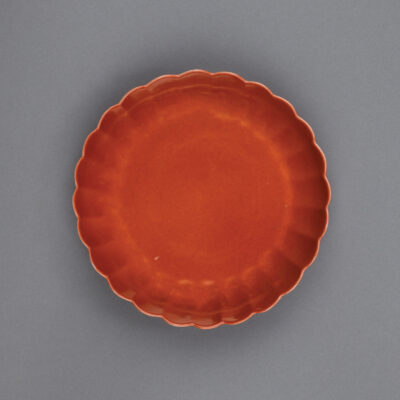11 – R1278
Description
Chinese imperial porcelain coral-red ground chrysanthemum-form flower dish, ju ban pan, the body with fluted petals and slightly inverted foot, covered overall in a rich and even coral-red enamel.
The base with a six-character mark of Yongzheng within a double ring in underglaze blue and of the period, 1723-1735.
6 ⅜ inches, 16.2 cm diameter.
Provenance & Additional Information
- From an English private collection.
- Sold by Sotheby’s London in their auction of Chinese Art, 12th May 2021, lot 54.
- Another of identical shape and size, in pink enamels, from the collection of Thomas English Cody (1889-1948) and the collection of S. Bazini, was sold by Poly, Beijing in their auction of Refined Gathering, Selection of Imperial Porcelain over 93 Years in Three Collections, sold by Marchant 20th June 2018, lot 5894, pp. 80-85. It is interesting to note that the mark on the present piece was likely written by the same person as the mark on the pink enamelled example.
- A white-glazed dish, also of identical shape and again with the mark probably written by the same hand, from the Tianminlou Collection is illustrated by Louise Alison Cort and Jan Stuart in Joined Colors, Decoration and Meaning in Chinese Porcelain, Ceramics from Collectors in the Minchui Society, Hong Kong, 1993, 40, p. 112; a yellow enamel example of the same shape and size, again with the mark probably written by the same person is illustrated by John Ayers in Chinese Ceramics in the Baur Collection, Volume 2, Geneva, 1999, no. 327 (A486), pp. 222/3; a pair of yellow dishes are illustrated by Claire Déléry in the 2017 exhibition of Porcelaine Chefs- d’Oeuvre de la Collection Ise, Musée Guimet, Paris, no. 68, pp. 186/7.
- The chrysanthemum, juhua, is a symbol of longevity and an important flower of It is the symbol of autumn and the flower of the ninth moon. It is also believed to have health-giving properties, and even today chrysanthemum tea is believed to lower blood pressure and cholesterol. Chrysanthemum-shaped pieces were a particular favourite of the Yongzheng and Qianlong Emperors.










